

Map of Medieval Europe in the 13th Century. Medieval Towns. There were few towns in Medieval England and those that existed were very small by our standards.
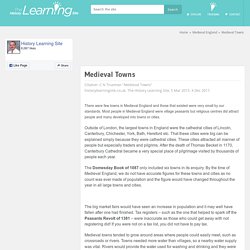
Most people in Medieval England were village peasants but religious centres did attract people and many developed into towns or cities. Outside of London, the largest towns in England were the cathedral cities of Lincoln, Canterbury, Chichester, York, Bath, Hereford etc. That these cities were big can be explained simply because they were cathedral cities. These cities attracted all manner of people but especially traders and pilgrims. After the death of Thomas Becket in 1170, Canterbury Cathedral became a very special place of pilgrimage visited by thousands of people each year.
The Domesday Book of 1087 only included six towns in its enquiry. The big market fairs would have seen an increase in population and it may well have fallen after one had finished. Medieval towns tended to grow around areas where people could easily meet, such as crossroads or rivers. The Middle Ages. Feudalism. The Medieval Church. The Medieval Church played a far greater role in Medieval England than the Church does today.

In Medieval England, the Church dominated everybody’s life. All Medieval people – be they village peasants or towns people – believed that God, Heaven and Hell all existed. Middle Ages Religion. Middle Ages Religion - The Christian Religion (Christianity)The Christian religion, or Christianity, is the name given to the system of religious belief and practice which was taught by Jesus Christ in the country of Palestine during the reign of the Roman Emperor Tiberius (42 BC - AD 37).
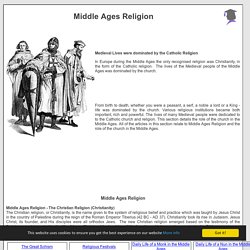
Christianity took its rise in Judaism. Jesus Christ, its founder, and His disciples were all orthodox Jews. Middle Ages Torture. Facts and information about various forms of tortures and executions can be accessed from the following links: Information about Tortures during the Medieval period of the Middle Ages Definition of TortureThe definition of torture is the the deliberate, systematic, cruel and wanton infliction of physical or mental suffering by one or more torturers in an attempt to force another person to yield information or to make a confession or for any other reason.
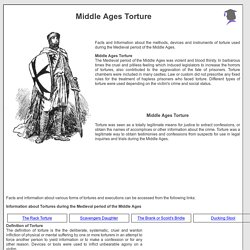
Devices or tools were used to inflict unbearable agony on a victim. Objectives of TortureThe objectives of torture were to intimidate, deter, revenge or punish. Or as a tool or a method for the extraction of information or confessions. Middle Ages Weapons. What are the weapons of the Middle Ages?
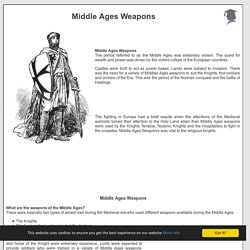
There were basically two types of armed men during the Medieval era who used different weapons available during the Middle Ages: The KnightsThe Foot soldiers, who included the Archers The Medieval men-at-arms held weapons according to their status and position which was determined by the Feudal system. The weapons, weaponry, armor and horse of the Knight were extremely expensive. Lords were expected to provide soldiers who were trained in a variety of Middle Ages weapons. The Knights themselves used different Middle Ages weapons riding on their warhorses - every knight had spent their whole lives gaining expertise in the use of the lance, swords and daggers. Medieval England - Medieval towns. A Medieval goldsmith shop TownsA new class emerged during the Middle Ages; the merchant.
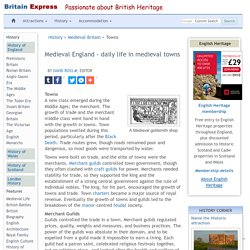
The growth of trade and the merchant middle class went hand in hand with the growth in towns. Town populations swelled during this period, particularly after the Black Death. Trade routes grew, though roads remained poor and dangerous, so most goods were transported by water. Search. ABC online education. ABC online education. Medieval Jobs. Interesting history, facts and information about the life of the people who lived in England during the Medieval times Medieval Jobs - The names of the Medieval people who worked on the manors The Lord of the Manor was based in the Manor House and from here he conducted the business of the manor.
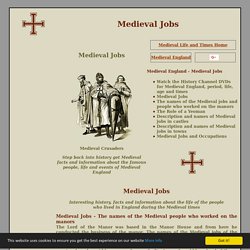
The names of the Medieval jobs of the people who worked on the manors are described as follows: Vassal - A Vassal or Liege was a free man who held land ( a fief ) from a lord to whom he paid homage and swore fealty. Medieval Life. The following articles are meant to provide both students and teachers with a full knowledge about medieval life.
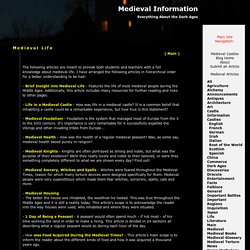
I have arranged the following articles in hierarchical order for a better understanding to be had: - Brief Insight into Medieval Life - Features the life of most medieval people during the Middle Ages. Additionally, this article includes many resources for further reading and links to other pages. - Life in a Medieval Castle - How was life in a medieval castle? It is a common belief that inhabiting a castle could be a remarkable experience; but how true is this statement? Medieval European History. Medieval European History The Dark Ages.
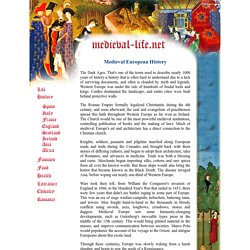
That's one of the terms used to describe nearly 1000 years of history-a history that is often hard to understand due to a lack of surviving documents, and often is clouded by myth and legends. The Middle Ages for Kids and Teachers - Middle Ages for Kids. EyeWitness To The Middle Ages and Renaissance. Life in a Christian Monastery, ca. 585"When he was dead his body was not placed with the bodies of the brethren, but a grave was dug in the dung pit, and his body was flung down into it. . .

" Crime and punishment in a medieval monastery: the monastery's Abbott provides insight into the monastic life. The Vikings Discover America, ca. 1000"There was no want of salmon either in the river or in the lake. " Five hundred years before Columbus, the Vikings discover a New World. Internet History Sourcebooks. Internet Medieval Sourcebook Paul Halsall, ORB sources editorLast Modified: Nov 4, 2011 [linked pages may have been updated more recently] The Internet Medieval Sourcebook is located at the Fordham University Center for Medieval Studies. MIDI: Sumer is icumen in 13C MIDI: Estampie 14C MIDI: Cantigas II 13C MIDI: Attaignant 16C MIDI: Veni Emmanuel trad MIDI: Alleluya: Nativitas 12C Music courtesy of The Internet Renaissance Band Play any of the above for appropriate music for browsing 1.
This project is both very large and fairly old in Internet terms. At the time it was instigated (1996), it was not clear that web sites [and the documents made available there] would often turn out to be transient. ABC online education. ABC online education. Transcript 00:00:00:00Shot of old building.00:00:01:08NARRATOR:Europe's historic landscapes are covered with tiny clues about ways of life that have long since disappeared.00:00:07:21Shot of person digging in an archaeological site.00:00:09:03NARRATOR:Finding these ancient clues is a major challenge. But when we do uncover something, each piece of evidence has its own stories to tell and helps build up an ever more accurate picture of what it was like to live hundreds or even thousands of years ago.00:00:26:22Shot of man and woman inspecting metallic object. No-one will ever be totally sure what medieval Europe was like. But if you put all the clues together, you begin to get a feel of how it might have been.00:00:38:14Man and woman continue to inspect metallic object.00:00:44:24Man places object in plastic crate.00:00:50:16MAN:Ah, good day.
Croeso. ABC online education. BBC Bitesize - KS3 History - Everyday life in the Middle Ages - Revision 1. KS3 Bitesize History - Everyday life in the Middle Ages : Revision, Page 5. KS3 Bitesize History - The Middle Ages. History: Middle Ages.